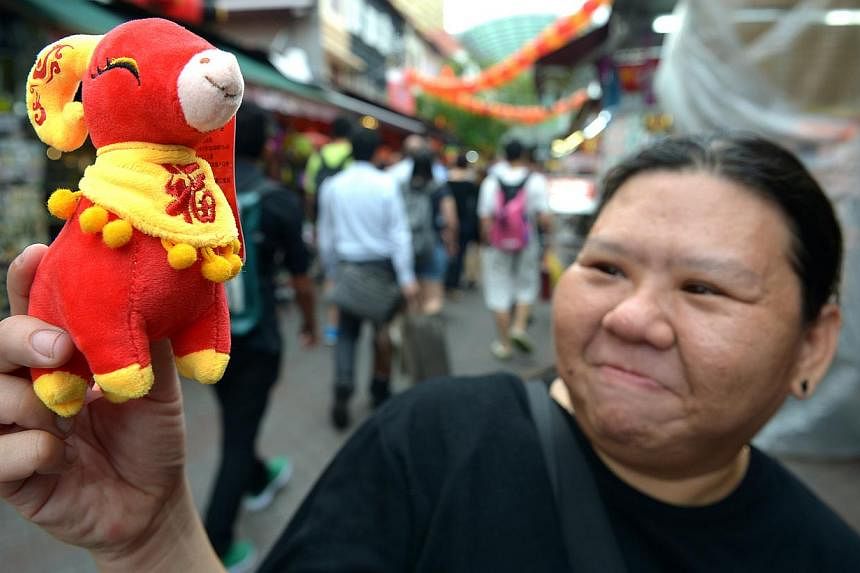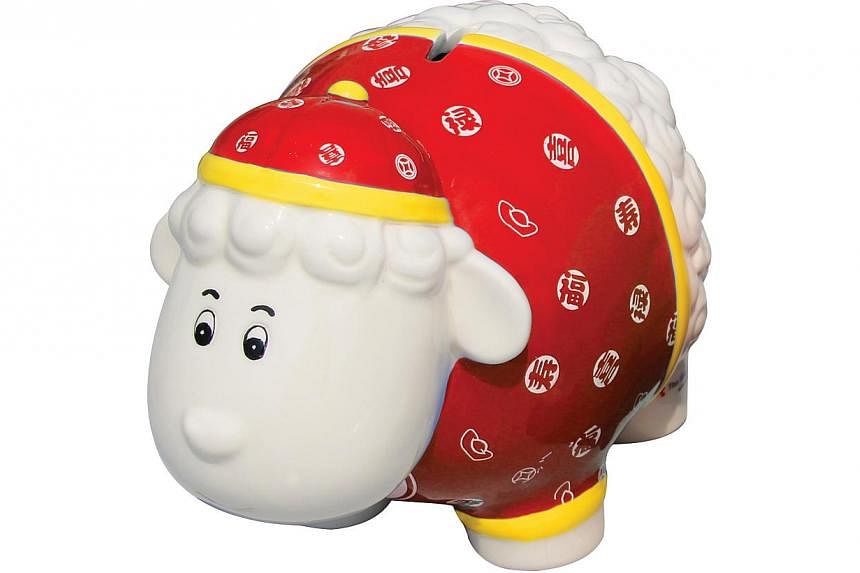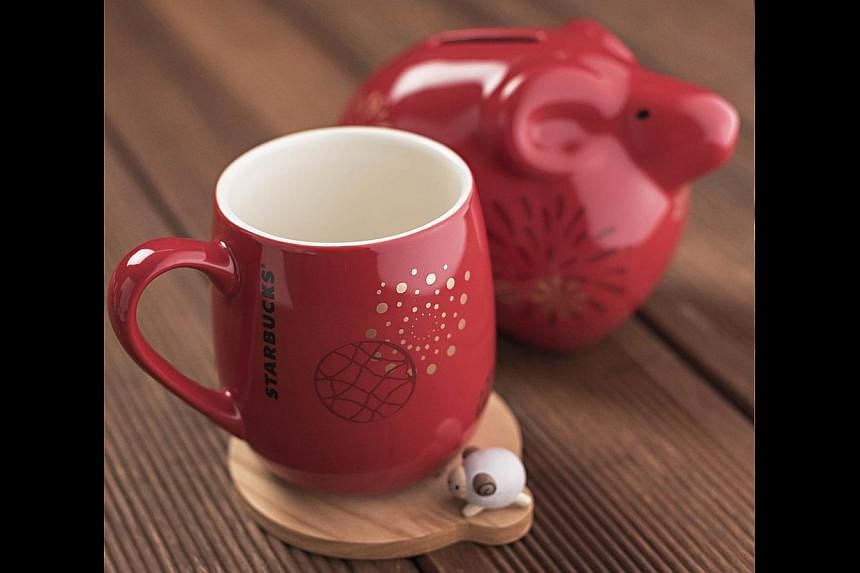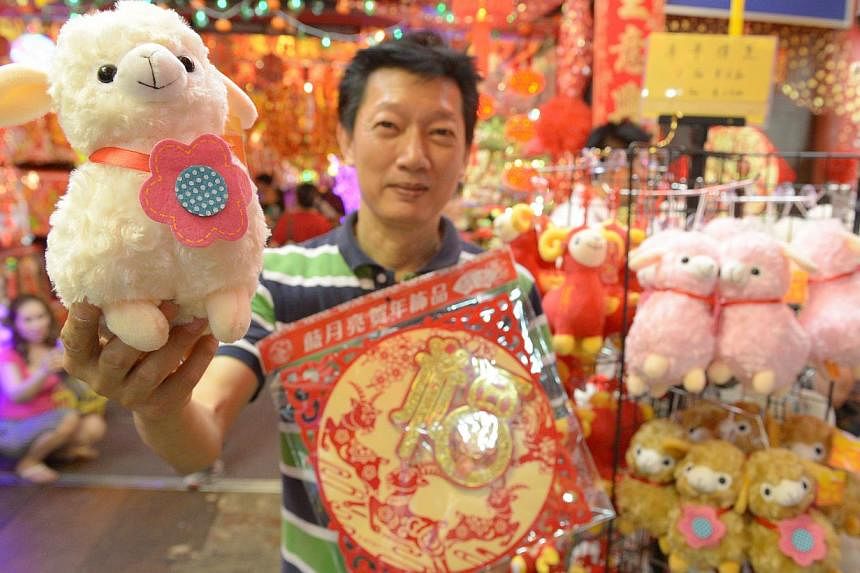With Chinese New Year just weeks away, Chinatown is all decked out and ready to usher in the Year of the Goat.
But take a quick trot around the area and you will soon see that the goat is facing some serious competition from another breed of livestock - the fluffy sheep.
It does not seem to matter that goats and sheep are entirely different species. People are putting zoology aside for the sake of aesthetics and voting cute sheep over spindly mountain goats when it comes to festive paraphernalia.
Technically speaking, the different interpretations are not wrong.
Assistant professor Lee Cheuk Yin, who heads the Department of Chinese Studies at the National University of Singapore, says: "As the Chinese character is yang, the zodiac sign could be interpreted as either shanyang (mountain goat), mianyang (sheep) or lingyang (gazelle) and still be technically correct."
If that is the case, how did the goat claim the coveted spot in the traditional Chinese zodiac in the first place?
The simple answer is that sheep and gazelles were not commonly found in ancient China, so the Chinese were not familiar with these other breeds.
Geomancer Thomas T., 50, who owns Geomancy Hut consultancy, says: "This is why, from a traditional perspective, it's inaccurate to call this the Year of the Sheep or Ram because the zodiac sign has always been associated with the mountain goat."
Another geomancer, Mr Kevin Foong, 35, agrees that the traditional Chinese zodiac is not open to interpretation.
"A goat's horns are a sign of strength, which makes it more majestic compared with the more docile sheep," he explains.
But he acknowledges that interpretations can evolve as cultures become more Westernised.
"As brands have to market to consumers, it's not surprising that they will be more likely to go for sheep-themed products, which are cuter and easier to sell," he says.
A tour around Chinatown bears this out, with cartoony interpretations of fluffy sheep plastered on everything from red packets to banners and lanterns.
At Chinatown store Giftmaster, which is selling mainly sheep soft toys for Chinese New Year, sales assistant Ivy Koh, 24, says: "Customers generally prefer sheep to goats as they're more adorable, so we stock more of those."
Ms Angelia Lim, 50, manager of another store in the area called Feng Shui Specialist, has stocked both goat and sheep merchandise for Chinese New Year.
While she has seen equal demand for both animals, she says: "It's usually middle- aged customers who opt for traditional goat merchandise, while the younger ones gravitate towards the sheep toys."
Ms Camille Lin, 33, a Taiwanese tourist who was shopping in Chinatown, says sheep are also beating out the goats in the marketplace at home.
"We have lots of cute sheep plush toys in Taiwan too. I don't think it dilutes the culture just because the zodiac sign is interpreted differently," adds the waitress.
Businesses seem to agree. SundayLife! found more than 10 companies who have opted to market and design their festive merchandise or promotional materials around sheep or rams instead of the traditional goat.
These include Nets, Starbucks, Schroders Investment Management and online retailer Zalora, as well as hotels such as Marina Mandarin, Hotel Jen, Hotel Re! and Royal Plaza on Scotts.
Lego also has a limited-edition Year of the Sheep set, which comes with a matching hongbao.
For Schroders Investment Management, choosing a sheep design for its corporate hongbao lent a contemporary touch.
Mr Jerry Low, its head of marketing, says: "During conceptualisation, we found references to goats, sheep and rams and, after researching the provenance of each, decided to give our design a more modern twist by featuring sheep instead of the more conventional goat."
Over at Royal Plaza on Scotts, general manager Patrick Fiat says the hotel opted to go with sheep for its marketing campaign as "their shape is rounder, which we felt was symbolic of fulfilment, unity and coming full circle in the Chinese culture". The hotel has also included lamb as part of its festive yu sheng (raw fish salad) special this year.
Do not let the proliferation of sheep get your goat though, as there is still plenty of merchandise that is sticking to tradition.
Both Singapore Post and The Singapore Mint have stuck to the classic interpretations of the goat for their official Chinese New Year stamp and coin collections.
But The Singapore Mint has gone one step further to cater to different tastes and generations. While it uses the mountain goat for its official coin design, a spokesman says the mint has also produced cute money boxes in the shape of sheep that are pitched at kids.
"The fluffy sheep seemed more relatable to prosperity and we thought it would appeal more to the younger generation," she adds.
Brands such as BreadTalk have also stayed loyal, naming its festive goat-shaped buns Happy Goat Luck.
At the end of the day, it does not matter whether you plump for the sheep or stick to the goat.
As undergraduate Natasha Chong, 20, puts it: "The most important Chinese New Year tradition is to celebrate with your family, no matter the animal on your red packet."
Additional reporting by Sarah Giam
Should the sheep stay out of the traditional Chinese zodiac? Write to stlife@sph.com.sg







